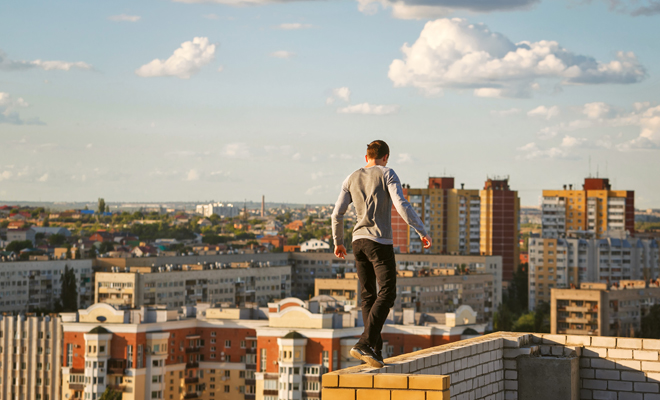 Fear is a totally irrational feeling. You can be afraid of an infinite number of things: spiders, public speaking, enclosed spaces, holes, and even love. Phobias produce an uncontrollable sensation that can become pathological if not treated in time. Among the millions of phobias that exist, one of the most common is the fear of heights or as it is technically defined: acrophobia.
Fear is a totally irrational feeling. You can be afraid of an infinite number of things: spiders, public speaking, enclosed spaces, holes, and even love. Phobias produce an uncontrollable sensation that can become pathological if not treated in time. Among the millions of phobias that exist, one of the most common is the fear of heights or as it is technically defined: acrophobia.
Do you feel unable to climb to the top of a mountain and look at the landscape from above? Are you terrified of thinking about stairs? Do you never get on the roller coasters at the amusement park because you are terrified of the feeling of being so high up? If you feel identified with these sensations, it means that you suffer from acrophobia and in this article we are going to explain what it consists of, what its symptoms are and what you can do to face it and overcome it.
What is acrophobia
Acrophobia is the intense fear of heights. This type of pathology has different degrees, but at its most extreme level, it can disable those who suffer from it, worsening their quality of life as a consequence. It is an irrational fear since it does not occur as a reflex action in the face of a danger that truly poses a threat.
Fortunately, in cities there are usually not as many places where people with acrophobia are exposed to high altitudes as is the case in mountainous environments. However, this fear can also occur in more everyday places such as steep or hand stairs, bridges, rooftops, balconies, elevators with transparent walls or glass floors.
In fact, in most cases, it is not even necessary to be close to a high area for the symptoms of acrophobia to break out. It is enough to imagine yourself in a place where there is a precipice nearby for a feeling of acute discomfort to begin to arise.
Acrophobia is a type of fear that affects many people in the world. It is considered that between 2 and 5% of the population suffers from it and, within this percentage, it is much more common in women than in men.
Acrophobia and vertigo are not the same
- First of all, we have to clarify what a phobia is since it is a term that is usually used incorrectly in everyday language. A phobia is a panic reaction that occurs when a person is exposed to a threat which is the product solely and solely of the fear of it. These responses are always produced by specific stimuli (cars, holes, insects…) and are disproportionate and exaggerated.
- That is to say, if suddenly one day a lion chases us and we feel an enormous fear, we cannot consider that we suffer from a phobia. This would be a completely normal reaction that would arise as an adaptive response to survive. However, if we get anxious every time we look out on a balcony, then we could use this term. Phobias are unjustified reactions and can become a real nightmare for those who suffer from it.
- Once the definition of phobia is clarified, we are ready to learn to differentiate between acrophobia and vertigo, two words that, erroneously, are also often used interchangeably as synonyms for each other.
- Vertigo, for its part, is an illusion that makes us perceive how things around us (including the ground) rotate or shake, causing us to lose balance. When this sensation occurs near a precipice or elevated area, it is known as height vertigo.
- The truth is that acrophobia and height vertigo are related, but technically they are not the same. In any case, the second could be considered one of the symptoms of fear of heights.
What are the symptoms of fear of heights?
There are different stimuli that unleash intense fear in acrophobes. Some people feel a deep discomfort thinking about the roof of a skyscraper while others suffer anxiety when practicing extreme sports that involve rising to a great distance from the ground. Within the different degrees of acrophobia that exist, the most common psychological and physiological symptoms are the following:
Muscle tension and tremors
The intense fear of heights is expressed through a state of muscular tension that causes agitation of the whole body through tremors. Why does this happen? The reason is that, at a time like this, the sympathetic nervous system is very accelerated and causes the muscle fibers to receive more activation stimuli so that they are ready to react quickly.
Anxiety
People who suffer from acrophobia can only think of all the kinds of misfortunes and possible accidents that can happen to them when they find themselves in front of a beginning or height. Anxiety arises as a physiological and cognitive response to focus your attention on possible dangers. Anxiety also leads to discomfort and prevents thinking rationally as it would be done in other contexts.
Panic, crying and screaming
The feeling of fear of heights can become so extreme and arise so abruptly that it can end up leading to a panic attack. This is due to the mixture of sensations that occur in the mind: acrophobic people can only think of pain and even death when facing a height.
Tachycardia and sweats
The blood pulse accelerates and, as a consequence, it causes a horrible feeling of lack of air.
Lost of control
People with a fear of heights, when they suffer an outbreak, are unable to manage well the management of attention as well as the establishment of plans and sequences of firm actions.
Headache
After having experienced all the above symptoms, it is very common for a headache to appear caused by changes in blood pressure and by over activation of the central nervous system.
How can I overcome my phobia of heights?
- There are thousands of ways to keep calm when the fear of heights overwhelms us. However, once this phobia becomes something pathological that seriously impairs the quality of life, it is best to go to a professional who recommends the appropriate treatment for each case. There are psychological evaluation instruments that allow us to find out if we are facing an excessive fear or not.
- Among all the therapies that allow treating this type of phobias, one of the most effective is cognitive behavioral therapy. This therapy has proven to be of great help for acrophobic people and we are going to talk about it below. What does it consist of? Very attentive.
Cognitive behavioral therapy, what is it?
- This therapy is the most used to treat phobias and is based on exposure techniques. That is, through it, methods are applied that progressively bring acrophobes closer to the object of their fears. In this way, they gradually acquire security and anxiety reactions are reduced.
- To carry out this type of therapy, you can go to a professional who will guide you and give you the appropriate guidelines, or submit yourself to self-exposure techniques in which you make more direct contact with your fears. This exhibition can be symbolic (using the resource of virtual reality) or live (physically going to high places) and can also be carried out in a group.
- Ideally, you should set simple, short-term goals. Once you have cleared an objective (such as staying near a cliff for 30 seconds) you must move on to a more difficult phase. In this way, you will gradually go through a series of tests ordered hierarchically according to their level of difficulty until you manage to overcome, to a greater or lesser extent, your phobia.
- The symptoms do not always disappear completely, but psychological intervention will most likely greatly increase the well-being of acrophobic people.
